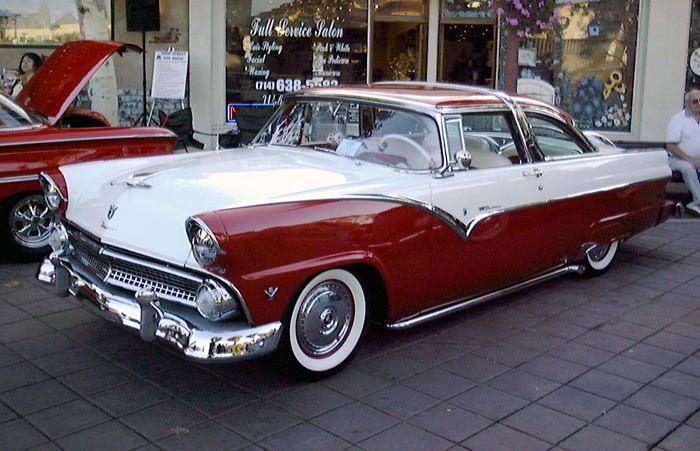Production 1955–1956 Layout FR layout | ||
 | ||
Assembly Chester, PennsylvaniaLong Beach, CaliforniaEdison, New JerseyCampbellfield, Victoria, Australia (Oceania only) Body style 2-door sedan4-door sedan2-door hardtop4-door hardtop2-door coupe2-door convertible2-door station wagon4-door station wagon2-door sedan delivery2-door coupe utility (Australia) | ||
The 1955 Ford is an automobile which was produced by the Ford in the United States for the 1955 model year and, in revised form, for the 1956 model year.
Contents
1955
The American Ford line of cars gained a new body for 1955 to keep up with surging Chevrolet, although it remained similar to the 1952 Ford underneath. The Mileage Maker I6 was bumped up to 223 CID (3.7 L) for 120 hp (89 kW) and the new-for-1954 Y-block V8 was now offered in two sizes: Standard Fords used a 272 CID (4.5 L) version with 162 hp (121 kW) with 2-barrel carburetor and single exhaust or 182 hp with 4-barrel carburetor and dual exhaust, but the large 292 CID (4.8 L) unit from the Thunderbird was also offered, boasting 193 hp (144 kW).
Apart from the engine changes, customers were sure to notice the new Fairlane, which replaced the Crestline as the top trim level, while a new Crown Victoria-style featured a chrome "basket handle" across the familiar (and continued) "Victoria" hardtop roof, which originally appeared on the Mercury XM-800 concept car. This use of a styling feature to visually separate the front of the passenger compartment from the rear reappeared on the 1977-1979 Ford Thunderbird, the Ford Fairmont Futura and Mercury Zephyr Z-7 coupes. The company now marketed three different rooflines on its two-door models; the tall two-pillar Mainline, Customline, and Fairlane sedans, pillarless hardtop Fairlane Victoria and the chrome-pillar Fairlane Crown Victoria. The Fairlane Crown Victoria was also offered with a transparent "skylighted" top. New brakes were used 11-inch (280 mm) drums. Also, Fords had a new frame, but still with five cross members.
The Fords introduced for 1955 also featured the panoramic windshields found on Oldsmobiles, Buicks and Cadillacs the previous year. With this panoramic windshield the A-pillars have a vertical angle. this gives the driver more panoramic visibility.
For the first time, Ford offered seat belts as a dealer option (not factory installed, with instructions provided by a Service Bulletin). Also new for 1955 was Ford's first factory installed air conditioner. This “Select Aire” option featured an integrated heater core and evaporator coil unit within the dash and cold air discharge vents located on top of the dash on either side of the radio speaker. The "Select Aire" design was carried over to the 1956 models with slightly different cold air vents in the same location as on the 1955 models. The condenser was mounted in front of the radiator as in later cars.
Station wagons were offered as a separate series for the first time in 1955. The Ranch Wagon and Custom Ranch Wagon were 2 door wagons whilst the Country Sedan and Country Squire models were 4 door wagons, the latter featuring wooden appliqué side mouldings.
1956
The eggcrate grille featured on the 1955 cars was widened into a series of rectangles for 1956, but this subtle exterior change was nothing compared to Ford's adoption of a 12-volt electrical system across the line. The Crown Victoria Skyliner's sales were plummeting with just 603 made, and it would be replaced by a convertible the next year. A new addition at midyear was the "Town Victoria" 4-door hardtop model which, along with the new Customline Victoria 2-door hardtop, were meant to compete with the Chevrolet Bel Air and Plymouth Belvedere. The Parklane, a Fairlane trimmed Tudor station wagon, was added to compete with the Chevrolet Nomad. There were new convenience options, such as a new air-conditioner system, a new heater, and a nine-tube signal-seeking radio. Instead of gauges, instrument cluster warning lights for oil pressure and ammeter were standard.
Victoria hardtop coupes now adopted the lower, sleeker roofline used by both 1955 and 1956 Crown Victoria, sans the wide chrome roof trim.
The Lifeguard safety package — consisting of seat belts, a padded dashboard, a deep-dish steering wheel, and a breakaway rearview mirror — was introduced. The option was a slow-seller. The optional air conditioner, which remained expensive and thus a slow seller, was totally revamped; the compressor was now housed beneath the hood and the cooling vents were moved to atop the dashboard (it could not be ordered on the Thunderbird).
Australian production
The 1955 Ford was also produced by Ford Australia which offered it as a V8 Customline 4-door sedan and as a V8 Mainline 2-door coupe utility. The latter body style was developed in Australia utilising an imported convertible chassis strengthened for load carrying. A limited number of Customline wagons was also built.
The 1955 model was the first Australian Ford to receive the new overhead-valve "Y-block" V8 engine, and went on sale at the end of July 1955. Australian Customlines and Mainlines received the 1956 US Ford facelift and then further makeovers in 1957 and 1958 with the final series utilizing the grille from 1955 Meteor of Canada. The 1957s, introduced in September 1957, were also available with the Fordomatic automatic transmission, and local parts content had been increased to 80 percent.
By 1958 the Customline was being marketed as the Ford V8 Fordomatic when supplied with automatic transmission. 1958 was also when the larger, 292 cu in (4.79 L) V8 engine was introduced. Australian production ended the following year with the introduction of the 1959 US Ford which was locally produced in Custom 300, Fairlane 500 and Ranch Wagon models.
